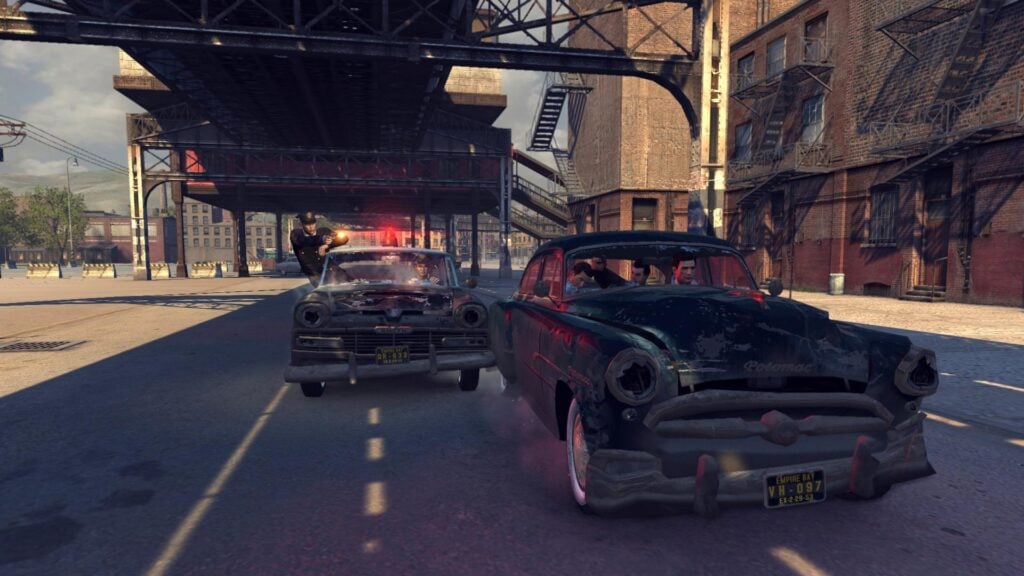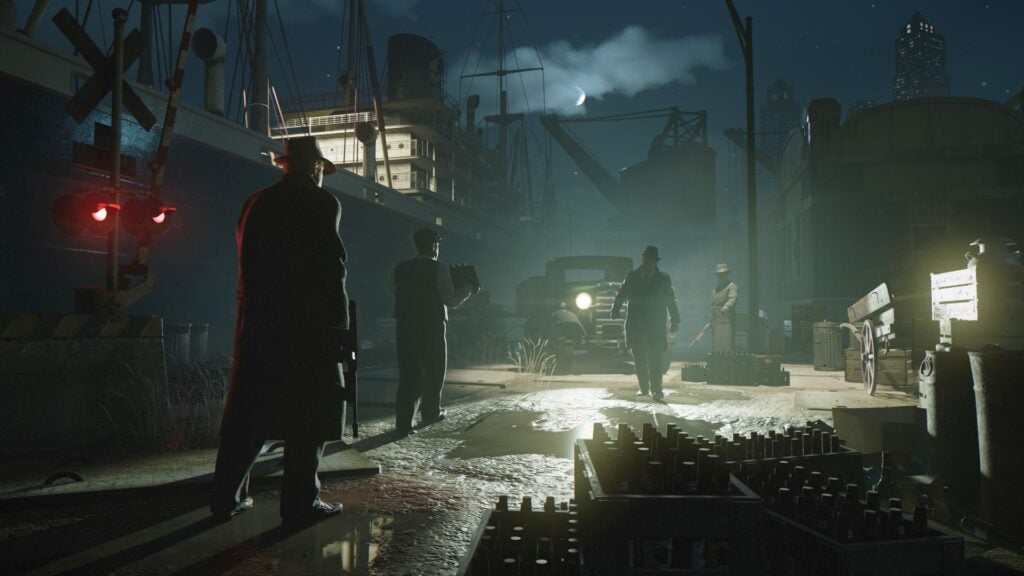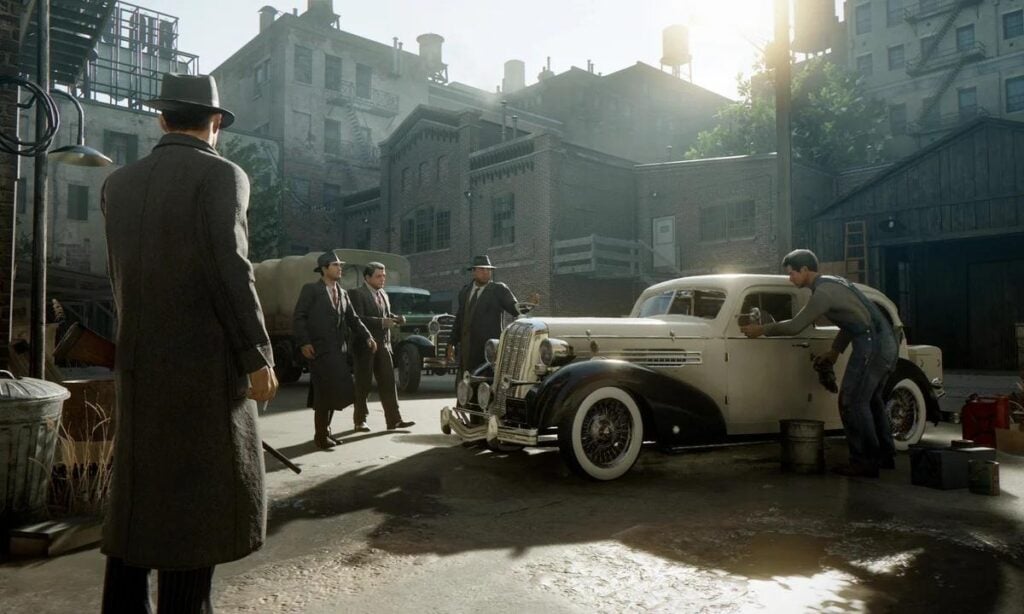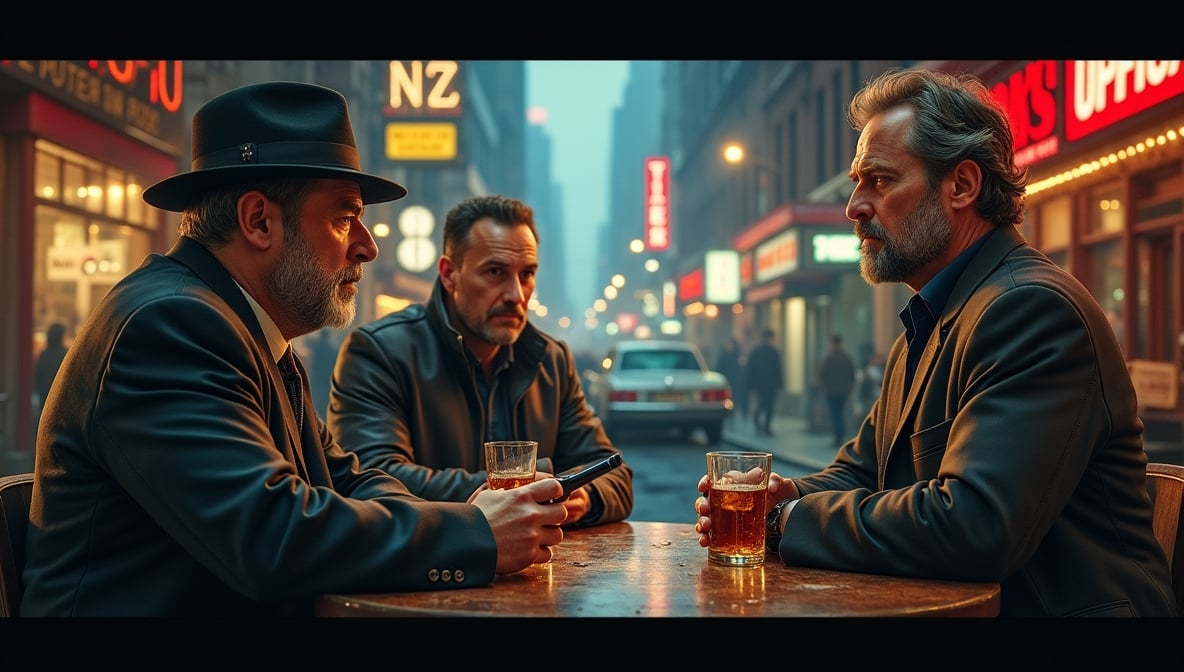It always starts the same way in a Mafia game: rain hitting the pavement, a dim streetlamp flickering, and someone making a choice they can’t take back. You’re not rushing around collecting trinkets or doing silly side gigs here; you’re living a life where every handshake, every glance, every favor could either save you or bury you. I still remember hearing the click of a lighter in Mafia: Definitive Edition’s opening; Tommy Angelo’s voice cutting through the smoke, ready to tell me the Mafia game series story of how a taxi driver turned into a made man.

- It offers remastered visuals, refined gameplay, and a cinematic dive into loyalty, betrayal, and the rise and fall of mobsters.
The Mafia Game Series Story
This is a saga that spans decades; each entry is a standalone story tied loosely through characters, shared history, and the unspoken truths of underworld life. Players often ask, “Do the Mafia games connect to each other’s stories?” The short answer is yes; lightly, through cameos and references, but each game is perfectly capable of holding its own. That said, the threads get more rewarding if you know the backstories. And no, these are not strictly “true stories,” though the games pull heavily from real-world events, politics, and organized crime lore to set their stage.
1. Narrative Design in the Mafia Series: More Than Just Cutscenes
Unlike many open-world games, Mafia runs on a tight narrative leash. You’re guided chapter by chapter, much like turning the pages of a crime novel. There are no bloated quest lists; just deliberate missions, high-quality cutscenes, and careful time jumps to keep the pace.
The games feel more like films partly because the developers pack in details that subtly whisper the Mafia game series story to you: the radio playing Depression-era big band songs as you drive, the way a character lights a cigarette before delivering bad news, the silence after a betrayal. Players often wonder, “Why does the Mafia series feel more like a movie than a game?” It’s because every component, pacing, framing, even weather during scenes, is sculpted to support the narrative, not distract from it.

- Tommy becomes entangled with the Salieri crime family, and he faces moral conflicts, betrayals, and a final twist that seals his tragic fate.
2. Mafia: The City of Lost Heaven (2002) & Mafia: Definitive Edition (2020); Tommy Angelo’s Rise and Fall
Stepping into 1930s Lost Heaven, you first meet Tommy Angelo as a hardworking cabbie who accidentally gets pulled into the Salieri crime family’s business. At first, you’re just doing “simple favors”: driving mobsters during a chase, delivering crates. But the moral slope is slick, and Tommy finds himself deeper in the life with every chapter.
So, does the remake change the story or just update the graphics? Mostly, it’s faithful; the 2020 remake keeps Tommy’s rise-and-fall arc intact but adds richer dialogue, more emotional texture, and expanded scenes, like Sarah and Tommy’s evolving relationship. The finale, Tommy’s ultimate betrayal of Salieri, leading to his quiet suburban years and eventual assassination, hits even harder when you’ve seen his charm give way to regret. That’s why players call it a classic tragedy. Watching Tommy fall isn’t a shock; it feels inevitable.

- Seeking wealth and respect, Vito’s rise is marred by betrayals, debts, and the harsh reality of mob life.
3. Mafia II (2010); Vito Scaletta and the Cost of Loyalty
When Mafia II opens, Vito Scaletta returns from World War II to his home city of Empire Bay, a city humming with postwar ambition and mob influence. His reunion with childhood friend Joe Barbaro is both the comfort and the curse of his journey. The two rise quickly through jobs for the city’s crime families, but every climb in the Mafia game series story comes with debts that dig deeper than the pockets can handle.
A mid-game betrayal changes everything; the kind that makes you pause the game just to take it in. Many new players ask, “Is Joe Barbaro’s fate connected to Mafia III?” Yes, indirectly; his absence in Mafia III has a grim in-universe explanation, and it adds weight when you revisit II. The ending? Vito is driven away, knowing his best friend isn’t coming with him; a bittersweet gunshot of a finale that some call the saddest in the series, others call the most authentic.

- Building his own criminal empire, Lincoln dismantles the mob piece by piece, facing moral choices that shape his legacy.
4. Mafia III (2016); Lincoln Clay’s Revenge and Rebuilding of a Criminal Empire
By the time Mafia III begins, it’s 1968 in New Bordeaux (a fictionalized New Orleans). Lincoln Clay, a Vietnam vet, comes home to find comfort with his surrogate family, the Black Mob. That comfort is shattered in one night by a bloody betrayal from the Italian mob, setting Lincoln on a mission that’s half vengeance, half hostile takeover of the city’s underworld.
The narrative stands out because it unfolds partly through documentary-style segments. Players often ask, “Why did Mafia III use that format?” It’s clever; framing Lincoln’s story as a retrospective gives weight to your choices and actions while letting the supporting cast reflect on him as if he were a real historical figure. As part of the larger Mafia game series story, Mafia III ties directly to Mafia II; Vito shows up in New Bordeaux, older, wearier, offering both muscle and subtle callbacks for those who know his past.

- Across its arcs, it follows flawed protagonists whose rise through the underworld inevitably leads to tragic consequences.
5. Overarching Story Connections and Timeline
If you’re debating “Should I play the Mafia games in release order or story order?”It depends on what you value. Story order would start with Mafia: Definitive Edition, then Mafia II, then Mafia III. Release order preserves the evolution of design and tone as the series matured.
Crossover characters like Vito, hints about Joe’s fate, and subtle nods in dialogue weave these games into a shared crime anthology. You don’t need to know the previous games to enjoy the next, but each cameo becomes a small reward when you do.

- The GTA series offers sprawling open worlds with modern satire, greater player freedom, and a mix of crime narratives and sandbox chaos.
6. Narrative Themes That Define the Mafia Series
If GTA feels like satire, Mafia feels like Shakespeare with pistols. These are stories about men caught between loyalty and betrayal, ambition and ruin, family and survival. Characters are sympathetic antiheroes; their choices make sense even when they’re morally bankrupt.
And here’s the real difference when someone asks, “What makes Mafia’s storytelling different from GTA’s?” In Mafia, the crimes are part of an overarching moral arc and an immersive period drama. You don’t cause chaos for chaos’s sake. Every kill, every theft, every meeting is part of a slow-burning tragedy.
7. How the Setting Shapes the Story
Lost Heaven’s rain-slicked Depression-era streets in Mafia feel melancholy and hungry. Empire Bay in Mafia II is pure postwar swagger; neon signs, chrome cars, and the sense that anyone can make it big (until they can’t). New Bordeaux in Mafia III brims with jazz, civil rights tension, and political corruption; all key settings in the Mafia game series story.
Which feels the most authentic? Fans will debate it all day, but Mafia II nails its period tone so well through its soundtrack and seasonal changes that it can trick your brain into believing the 1950s were exactly like this. The settings aren’t just backdrops; they’re part of the story’s DNA.

- Period-accurate environments, politics, and social tensions shape the characters’ motivations and the kinds of crimes they commit.
8. To Sum Up: Why Mafia’s Storytelling Still Matters
What makes these games endure is their refusal to treat the player like just an action junkie. You’re not a faceless thug; you’re Tommy, Vito, Lincoln. You live their daily grind, their small triumphs, and their final, quiet reckonings. Long after you finish the last mission, you’ll remember details like the way Sarah smiled at Tommy in a rare moment of peace, the sound of Joe’s laugh in a diner booth, or the look on Vito’s face when he realized who wasn’t in the car. That’s the Mafia game series story effect; it doesn’t just give you a story. It gives you a life you’ve lived.
FAQs
Q1: Was there ever a Mafia game set outside the United States?
No, all mainline Mafia games are set in fictional American cities inspired by real ones, but they’ve never left the country.
Q2: Do any of the Mafia games have multiple endings?
Not in the main trilogy; all follow a set ending to preserve their cinematic storytelling approach.
Q3: Have the developers confirmed if Mafia IV will connect to the trilogy?
As of now, Hangar 13 has acknowledged they’re working on a new Mafia game, but haven’t confirmed if it will be connected to existing characters.
Q4: Can you free roam after finishing the story in any Mafia game?
Yes, Mafia II and Mafia III both allow free roam with side content after the main story’s credits roll, though Mafia: Definitive Edition requires Free Ride mode for open exploration.


